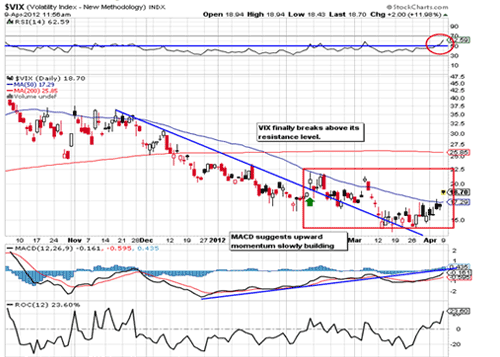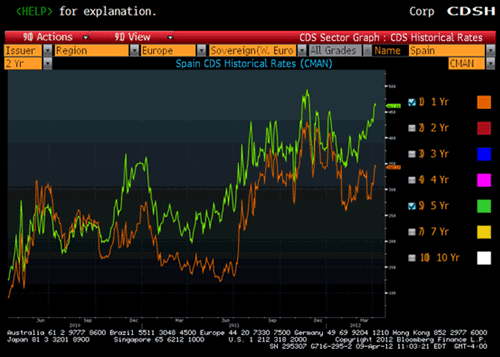Does the Rally Still Have Legs?
And Things to Keep an Eye on in the Second Quarter
by Alfred Lee, CFA, CMT, DMS
Vice President & Investment Strategist, BMO ETFs & Global Structured Investments
BMO Asset Management Inc.
alfred.lee[@]bmo.com
April 12, 2012
Recent Developments:
- U.S. equities registered their best first quarter in 14 years. A definite surprise given the macro-economic and geo-political concerns coming into the new-year. The S&P 500 Composite Index had a total return of 12.6% over the quarter, while the more blue-chip oriented Dow Jones Industrial Average returned 8.8% and the more tech-heavy Nasdaq-100 Index returned an impressive 21.2% over the same period (all in local currency terms). Over the last 16-months, we have recommended an overweight to U.S. equities and continue to do so.
- Much of the rally was attributed to the European sovereign debt concerns being placed on the backburner as policy measures put in place by European Central Bank (ECB), were successful in preventing a liquidity crisis over the short-term. With decreased concerns of an immediate tail-risk event1, global investors shifted their focus to U.S. economic data, which continued to gather momentum, especially on the consumer confidence front. While the first quarter rally had significant breadth, with only the telecom sector trading below its 200-day moving average, three sectors did much of the heavy lifting in driving U.S. equities higher. These sectors were financials, technology and consumer discretionary.
- On a fundamental level, most global equity markets still look attractive from our point of view, with most major equity indices trading below their 10-year averages in price-to-earnings (P/E) ratios, leaving the opportunity for further multiple-expansion if macro-economic risks remain subdued.
- We have been keeping a very close eye at the CBOE/S&P Implied Volatility Index (VIX) over the last four months, trying to find indications of when and if volatility will return. As mentioned in one of our prior reports, the VIX had hit an intraday low of 13.99 several weeks ago, which is abnormally low even in a secular bull-market. Last week, the VIX did pop from 15.83 to 16.65 on an intraday basis on the release of the U.S. Federal Reserve Board minutes. The VIX also moved even higher on news of a weak Spanish debt auction late last week and earlier this week, when the market reopened as a result of last Friday's non-farm payroll coming in well short of expectations (Chart A). Though the VIX, which currently sits at 18.51, is still below its long-term average of 20.0, it has recently become more reactive to negative headlines, especially compared to its behaviour early in the first quarter. (Chart B). While not an immediate concern, whether equity market volatility can remain compressed is something to keep an eye on in the second quarter.
- Another key indicator to watch for is the price of insuring against a default of Spanish sovereign debt, through the price of its credit default swaps (CDS). More specifically, if the spread between 1-year and 5-year CDS prices on Spanish sovereign debt begins to contract, then the market will likely shift its focus back to the European debt crisis. (Chart C).
Investment Idea:
- If we continue to see an absence of macro-economic concerns, the upcoming U.S. earnings season will likely set the tone for the second quarter. Investors should also keep in mind that the ECB's Long-term Refinancing Operation (LTRO) was designed to prevent an immediate liquidity crisis and not resolve long-term solvency issues. Given the strong rally in the first quarter, investors may want to consider a more defensive approach in their equity positioning as the technical underpinnings of the market suggest a near-term consolidation. Furthermore, diversification and tactical positioning will remain the key to success in 2012.
- For equity exposure, we remain bullish on the U.S. and prefer non-cyclical areas and/or dividend oriented areas in Canada. For fixed income and credit, we continue to recommend overweighting the short- and mid-part of the yield curve and prefer federal and corporate bond exposure. U.S. high yield corporate bonds and emerging market debt are also currently offering attractive yield at very reasonable volatility levels. Please refer to our most recent Monthly Strategy Report, "Silent Rivers Run Deep," which can be found on our homepage (www.bmo.com/etfs) for our current strategic and tactical portfolio positioning using ETFs.
Chart A: Frequent Gaps in VIX Indicates Increasing Investor Nervousness

Source: Bloomberg, BMO Asset Management Inc.
Chart B: Volatility Looking Bottomed Out

Source: Stockcharts.com, BMO Asset Management Inc.
Chart C: Could Spain be the Next Problem Child in the European Debt Crisis?

Source: BMO Asset Management Inc.
*All prices as of market close April 9, 2012 unless otherwise indicated.
1 Tail-risk event: The risk of an outlier or improbable event occurring. Statistically, the event is said to be three standard deviations or more away from the mean, under a normally distributed curve.
Disclaimer:
Information, opinions and statistical data contained in this report were obtained or derived from sources deemed to be reliable, but BMO Asset Management Inc. does not represent that any such information, opinion or statistical data is accurate or complete and they should not be relied upon as such. Particular investments and/or trading strategies should be evaluated relative to each individual's circumstances. Individuals should seek the advice of professionals, as appropriate, regarding any particular investment.
BMO ETFs are managed and administered by BMO Asset Management Inc, an investment fund and portfolio manager and separate legal entity from the Bank of Montreal. Commissions, management fees and expenses all may be associated with investments in exchange-traded funds. Please read the prospectus before investing. The indicated rates of return are the historical annual compound total returns including changes in prices and reinvestment of all distributions and do not take into account commission charges or income taxes payable by any unit holder that would have reduced returns. The funds are not guaranteed, their value changes frequently and past performance may not be repeated.











